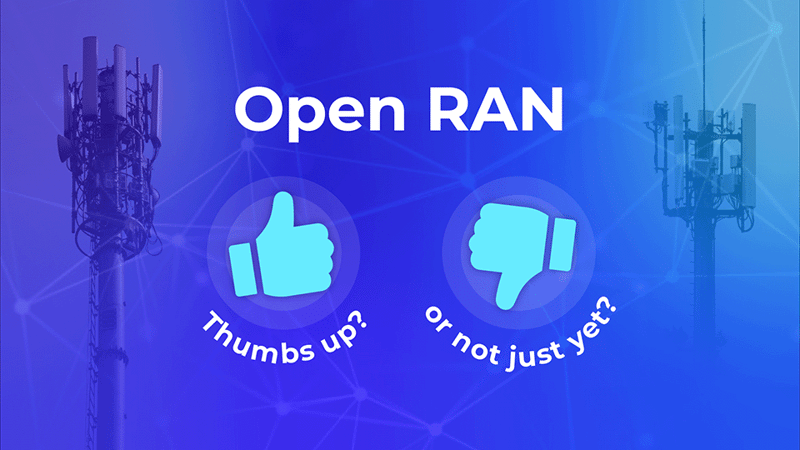
According to Telecoms experts’ Open RAN is a big opportunity for the telecom ecosystem as it allows the mobile network providers to have a broad choice of RAN. It has also been expected that the RAN market surpasses $32 billion by 2030 with a 42% growth rate. The substantial questions that every operator has are: Is this an opportunity for all MVNOs? What are the cons and pros, and what are the main differences between the traditional RAN and the open RAN?
Open RAN has been improved for the past seven years but lately has had more attention than usual due to the evolution of the 5G network. Open RAN, ORAN, O-RAN, so many ways have been used to describe the same but after all what Open RAN means?
Open RAN stands for Open Radio Access Network and has been specified as a network in which disaggregated components are connected via open interfaces and optimized by intelligent controllers, allowing multiple manufacturers to interact via defined interfaces.
With the rapidly transitioning to 5G applications, many communication service providers (CSPs) are eager to expand their infrastructures to the edge and build a bigger ecosystem of RAN suppliers to assist in the discovery of new and novel income opportunities. New technology products, such as Open RAN, present CSPS with a unique chance to establish an open infrastructure with flexibility and, as a result, facilitate future expansion for future technologies.
There are some key differences between the traditional RAN and the open RAN, from its software modularity to its deployability, that can be or not be more beneficial to your business reality, needs and upcoming goals.
If we take a look at the traditional RAN we can expect a proprietary platform, which provides a slow time to market and a high innovation cost, an embedded software, a fixed application and network adaptability (pre-programmed control logic and fixed networks resources), and an integrated deployability and manageability.
Now, let’s deconstruct the Open RAN. We are facing a software-defined platform (open hardware and software efficiencies), with unbundled software (open APIs and disaggregated control/data) and a programable application and network based on real-world network conditions. The deployability and manageability have a flexible architecture.
In terms of technologies and work approach the difference between the “old” and the “new” are significant and can be a key differentiator when we look in quickly differentiate our telco, capitalize on the investment and have a quick response to the market changes. Let’s unleash the opportunities and challenges that a mobile network operator can face it.
Capitalizing with open RAN – the big opportunity
-
For many telecoms, the change from a static and vertical infrastructure to a dynamic horizontal one represents an intriguing playing field. Open RAN is particularly appealing in underdeveloped markets, where average revenue per user (ARPU) is low and operators struggle to produce a strong Return on Investment (ROI). Open RAN has the potential to allow operators to lessen their reliance on a single vendor for wireless network components, providing operators with greater flexibility and the opportunity to cut costs by not being bound to a single vendor's products and prices;
-
CSPs can use the openness and interoperability of technology to design and adapt solutions that are compatible with a wide range of hardware and software platforms, allowing operators to access a bigger market and perhaps enhance their revenues, by giving them more freedom to upgrade their networks and develop new services, resulting in lower-cost coverage;
-
As a result, CSPs can update their networks and develop new revenue streams for their services. However, like with any open-source technology, developing Open RAN will necessitate collaboration and knowledge-sharing among major technology providers across the industry. Only then will this technology be able to realize its full potential and benefit everyone.
Unleashing the challenges of this “new” RAN
- Requires significant investments in new hardware and software;
- Needs a higher degree of skill and coordination than traditional, single-vendor networks, which brings us back to the cost issue;
- Security risks: as it potentially exposes operators' networks to a broader range of hardware and software components, each of which may be vulnerable. With more solution providers deciding to host their 5G networks on the public cloud, the increase in entry points becomes problematic and necessitates extra security layers. Furthermore, multi-vendor testing will be required for network assurance. To ensure the security and resilience of their networks, operators will need to carefully identify and manage these risks.
Although this looks very promising for the future of the telecom industry, not all the mobile networks can afford to invest in this method, since we are looking into a large investment in goods and training. But, for medium and large operators we are looking into a game-changing industry.
To summarize we asked Lifecycle Software CEO, Kelvin Chaffer, with more than 20 years of experience in the telecom industry, what is his perspective about Open RAN. "With the world rapidly switching to 5G applications, many communication service providers (CSPs) are looking to expand their infrastructures to the Edge and create a broader ecosystem of RAN vendors to help find new and innovative revenue opportunities. New technology products such as Open RAN provide CSPS with a unique opportunity to have flexibility in deploying an open infrastructure and, as a result, support future growth for future technologies."


